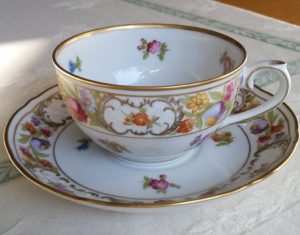 The following study was done in England, but the results should be taken seriously and may (probably) apply to the US also - painted and enameled glassware ("externally decorated glassware") may contain high levels of lead and cadmium. The researchers found that more than 70% of the products (52 out of 72) tested positive for lead, and the metal was found in all colors, including the decorated gold leaf of some items. A similar number (51 out of 72) tested positive for cadmium, with the highest concentrations usually encountered in red enamel.
The following study was done in England, but the results should be taken seriously and may (probably) apply to the US also - painted and enameled glassware ("externally decorated glassware") may contain high levels of lead and cadmium. The researchers found that more than 70% of the products (52 out of 72) tested positive for lead, and the metal was found in all colors, including the decorated gold leaf of some items. A similar number (51 out of 72) tested positive for cadmium, with the highest concentrations usually encountered in red enamel.
They found this in products manufactured both in Europe and China - which is why I think the results apply to painted or decorated glassware in the USA also. It probably also applies to some (many?) painted ceramics. So beware! If you use painted or enameled glassware, you are at increased risk for ingesting lead and cadmium, both of which are linked to health problems - especially for developing fetuses and children. The best safe level of each is zero. The researchers mention that there are newer alternatives that are safe (lead and cadmium free). From Science Daily:
Drinking glasses can contain potentially harmful levels of lead and cadmium
Enameled drinking glasses and popular merchandise can contain potentially toxic levels of lead and cadmium, a study has shown. Researchers at the University of Plymouth carried out 197 tests on 72 new and second-hand drinking glass products, including tumblers, beer and wine glasses, and jars.
They found lead present in 139 cases and cadmium in 134, both on the surface of the glasses and, in some cases, on the rims, with concentrations of lead sometimes more than 1000 times higher than the limit level. Tests showed that flakes of paint often came away from the glass under when simulating sustained use, indicating the substances could be ingested over a prolonged period.
The study, published in Science of the Total Environment, analysed a range of glassware using portable x-ray fluorescence (XRF) spectrometry. More than 70% of the products (52 out of 72) tested positive for lead, and the metal was found in all recorded colours, including the decorated gold leaf of some items. A similar number (51 out of 72) tested positive for cadmium, with the highest concentrations usually encountered in red enamel.
The lead concentrations ranged from about 40 to 400,000 parts per million (ppm), while quantities of cadmium ranged from about 300 to 70,000 ppm. According to the US Office of Environmental Health Hazard Assessment, the limit levels for the externally decorated lip area of drinking glass are 200 ppm and 800 ppm respectively.
In the research, Dr Turner highlights that the Federation of European Screen Printers Associations says organic inks are becoming more popular than metallic pigments because of environmental concerns, and that such inks were evident on a number of newly-purchased products which proved negative for lead and cadmium.
He also says that additional analyses confirmed that hazardous elements are also used to decorate a wider range of consumer glassware that has the potential to be in contact with food, including the exteriors of bottles for the storage of beer, wine or spirits, the external text and logos on egg cups, jugs and measuring cups, and the undersides of coasters and chopping boards. "Given that safer alternatives are available to the industry, the overall results of this study are both surprising and concerning," Dr Turner added. "Why are harmful or restricted elements still being employed so commonly to decorate contemporary glassware manufactured in China, the European Union and elsewhere? " [Original study.]
